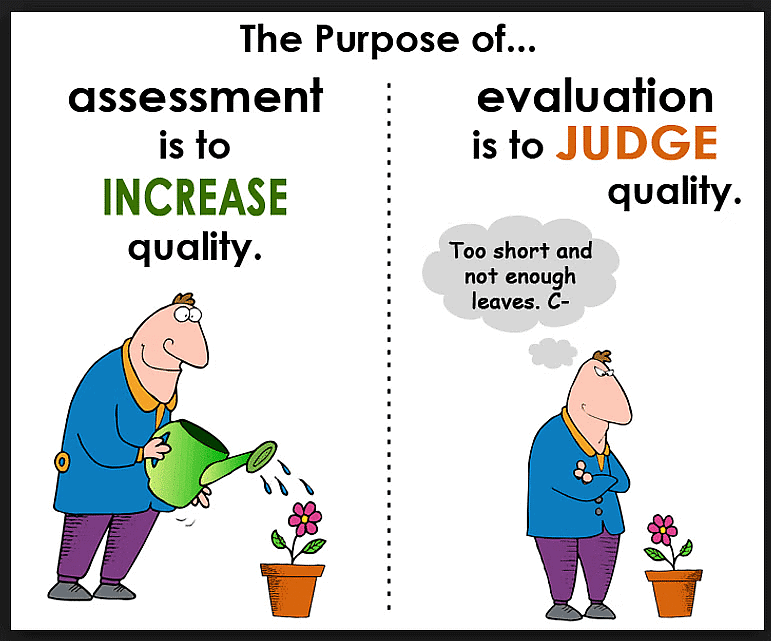Notes: Assessment and Evaluation | Child Development and Pedagogy for CTET Preparation - CTET & State TET PDF Download
Every learning experience should be accompanied by an assessment process. Effective assessment informs us about the level and breadth of learning achieved. It also identifies areas for improvement. Without evaluation, learners may continue to make mistakes. Although assessment parameters may vary across different domains, the ultimate goal remains improvement.
 Evaluation Criteria
Evaluation Criteria
Learning has been defined as an act of acquiring new, modifying, and reinforcing existing knowledge, behaviors, skills, values, or preferences, which may lead to potential changes in generating new information, and changing attitudes or behaviors related to the type and range of experiences.
It is important to evaluate learning, particularly in education, to ensure that learning has actually been achieved.
Evaluation
Education is a continuously changing process and thus needs continuous evaluation. Measurement is a precondition for evaluation. Measurement is quantitative and objective, while evaluation is qualitative and subjective. Therefore, while measurement aims only at ascertaining quantity, evaluation aims at identifying and correcting weaknesses discovered.
Evaluation is largely based on educational objectives and the learning experience. This can be represented as the Triangle of Evaluation:
Differences between Assessment and Evaluation
- Assessment: The process of objectively understanding the state or condition of a thing by observation and measurement. For instance, assessment of teaching means measuring its effectiveness.
- Evaluation: The process of observing and measuring a thing for the purpose of judging it and determining its value, either by comparison to similar things or to a standard. Evaluation of teaching means passing judgment on the teaching as part of an administrative process.
- Formative Assessment: Conducted by tests, assignments, projects, and observations to gauge the effectiveness of teaching activities. It provides feedback to learners about their performance.
- Summative Assessment: Measurement aimed at determining overall learning outcomes. Summative assessment is what is commonly referred to as evaluation.
How to Evaluate?
Generally, two methods of evaluation have been used in education: norm-referenced evaluation and criterion-referenced evaluation.
- Norm-Referenced Evaluation:
- Refers to standardized tests designed to compare and rank test takers in relation to one another.
- Norm-referenced tests compare scores against a statistically selected group of test takers of the same age or grade level.
- These tests involve questions in multiple-choice format used in competitive examinations.
- Criterion-Referenced Evaluation:
- Measures student performance against fixed criteria or learning standards.
- Criteria are concise descriptions of what students are expected to know and do at specific stages of their education.
- These tests are extensively used in school education to evaluate whether students have learned specific knowledge or acquired particular skills.
Reasons for Evaluation
- Ensuring Learning has Taken Place: Assessment should provide information about the levels of understanding that students are reaching. Frequent feedback to learners helps them monitor their learning and evaluate their strategies.
- Ensuring Teacher’s Effectiveness: Effective teaching starts with setting student learning objectives. Teachers must assess students based on these objectives rather than arbitrary standards.
- Creating a Quality Learning Environment:A quality learning environment is:
- Learner-Centered: It pays attention to the knowledge, skills, attitudes, and beliefs that learners bring.
- Knowledge-Centered: It focuses on helping students become knowledgeable and understanding.
- Assessment-Centered: Provides opportunities for feedback and revision that match students’ learning goals.
- Community-Centered: Includes the classroom, school, and larger community, fostering connections between students, teachers, and administrators.

Types of Assessment in Education
There are three main types of assessment commonly used in school education. These are as follows:
1. Formative Assessment
- Definition: Formative assessment occurs over the short term, as learners are in the process of making meaning of new content and integrating it into what they already know.
- Characteristics:
- Feedback to the learner is quick, enabling learners to change their behaviors and understanding.
- It also allows teachers to rethink their instructional strategies, activities, and content based on student understanding and performance.
- The teacher’s role here is akin to that of a coach.
- Formative assessment can be informal (like observing learner's work) or formal (like a written test). It is the most powerful type of assessment for improving student understanding and performance.
2. Portfolio Assessment (Interim Assessment)
- Definition: Portfolio assessment takes place occasionally over a longer time period.
- Characteristics:
- Feedback to the learner is more formal, using assessment tools such as projects, written assignments, and tests.
- Learners should be given opportunities to re-demonstrate their understanding once they have understood and acted upon the feedback.
- Interim assessments help teachers identify gaps between students’ understanding and their instruction.
- Teachers should address these gaps before moving on or by incorporating solutions into upcoming instructions and activities.
3. Summative Assessment
- Definition: Summative assessment takes place at the end of a large period of learning, such as the end of a term or year.
- Characteristics:
- Results are primarily used by teachers and schools to identify strengths and weaknesses in curriculum and instruction, with improvements affecting the next year's/term's students.
- Feedback to the student is usually limited and there is no opportunity for reassessment.
- Summative assessment tends to have the least impact on improving an individual student's understanding or performance.
- Students/parents can use the results to understand where the student's performance lies compared to a standard or group of students.
Distinction Between Assessment for Learning and Assessment of Learning
- Assessment for Learning (Formative Assessment): The process of looking for and interpreting evidence for use by learners and their teachers to decide where the learners are in their learning, where they need to go, and how best to get there.
- Assessment of Learning (Summative Assessment): Occurs when teachers use evidence of students’ learning to make judgments on students' achievement against goals and standards.
- Assessment as Learning (Feedback to Learners): Use of tasks or activities that help students use assessment to improve their own learning. Self and peer assessments allow students to reflect on their learning and make adjustments to achieve deeper understanding.
School-Based Assessment (SBA)
School-Based Assessment (SBA) is conducted by teachers at the school level, following the guidelines set by the respective Board of Education. It takes place entirely within the school without external involvement.
Key Features of SBA:
- Child-Centered and Multi-Dimensional: SBA supports the overall growth of students, including their social, physical, emotional, and intellectual development.
- Teacher Autonomy: Educators have complete authority over the assessment process without any outside interference.
- Transparency: SBA is more open and clear compared to Summative Assessment.
- Comprehensive Learning Insight: It helps teachers understand what students have learned, their learning methods, the challenges they face, and their areas of interest.
- Limitations of Traditional Evaluation: Earlier, school board exams were the primary method of assessment, focusing only on academic performance. This system overlooked students' actual skills and did not account for their progress over time.
- Focus on Continuous Development: SBA now emphasizes skill-building, identifying learning gaps, and providing necessary support. In line with this approach, the Central Board of Secondary Education (CBSE) introduced SBA as Continuous & Comprehensive Evaluation (CCE) in 2010 to enhance student learning outcomes.
Continuous and Comprehensive Evaluation (CCE)
Continuous and Comprehensive Evaluation (CCE) is a school-based assessment system that focuses on the holistic development of students by evaluating both scholastic and co-scholastic aspects of learning. When implemented effectively, CCE is expected to bring significant improvements over the traditional lecture-based teaching method.
Perspective of CCE
The primary goal of CCE is to enhance the teaching-learning process by identifying students' learning gaps and providing constructive feedback.
- Encouraging Improvement: CCE views assessment as a way to motivate students to enhance their future performance.
- Implementation at the Secondary Level: Introduced by CBSE up to Class 10, CCE divides the academic year into two terms.
- Assessment Structure:
- Each term includes one Summative Assessment (SA) and two Formative Assessments (FA) for every subject.
- Formative Assessments (FA): Monitor students’ progress through classwork, homework, quizzes, and projects.
- Summative Assessments (SA): Conducted at the end of each term to evaluate students' understanding.
Scholastic and Co-Scholastic Domains
- Scholastic Areas: Focus on intellectual development through subjects, assignments, projects, and tests.
- Co-Scholastic Areas: Cover skills such as psychomotor abilities, life skills, and attitudes.
Implementation in Practice
- Both scholastic and co-scholastic aspects are crucial for a child’s overall growth and require proper evaluation.
- According to CBSE, schools assess co-scholastic areas using multiple methods based on set criteria, including checklists and life skill indicators.
- Challenges in Implementation:
- In reality, scholastic assessment dominates, while co-scholastic evaluation is often neglected and treated as a mere formality by teachers.
- To compensate for these gaps, some parents take initiative in helping children explore and develop their personal interests outside of school.
|
67 videos|154 docs|41 tests
|
FAQs on Notes: Assessment and Evaluation - Child Development and Pedagogy for CTET Preparation - CTET & State TET
| 1. What are the different types of assessment in education? |  |
| 2. What is the distinction between assessment for learning and assessment of learning? |  |
| 3. How do assessment and evaluation differ in the context of education? |  |
| 4. What is the importance of using different types of assessment in education? |  |
| 5. How can educators effectively incorporate assessment practices into their teaching? |  |
















